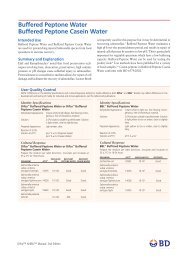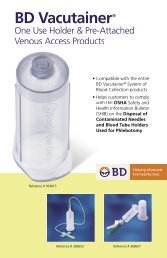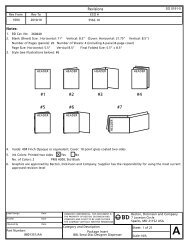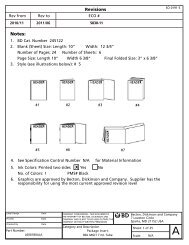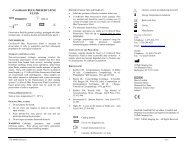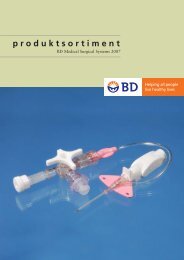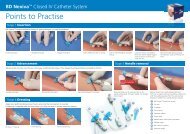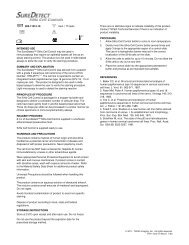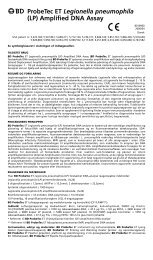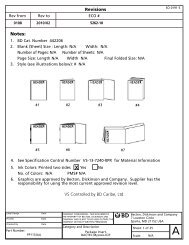Methylene Blue Loeffler Stain Droppers - BD
Methylene Blue Loeffler Stain Droppers - BD
Methylene Blue Loeffler Stain Droppers - BD
Create successful ePaper yourself
Turn your PDF publications into a flip-book with our unique Google optimized e-Paper software.
Revisions<br />
Rev from Rev to ECO #<br />
0703 2010/06 5347-10<br />
Notes:<br />
1. <strong>BD</strong> Cat. Number 261204<br />
2. Blank (Sheet) Size: Length: 11” Width: 22.5”<br />
Number of Pages: 10 Number of Sheets: 1<br />
Page Size: Length 11” Width 4.5” Final Folded Size: 4.5” x 1 7/8”<br />
3. Style (see illustrations below): # 4<br />
#1 #2 #3 #4<br />
#5 #6 #7<br />
4. See Specification Control Number L001217 for Material Information<br />
x<br />
5. Ink Colors: Printed two sides Yes No<br />
No. of Colors: 1 PMS# 2755 <strong>Blue</strong><br />
6. Graphics are approved by Becton, Dickinson and Company. Supplier has the<br />
responsibility for using the most current approved revision level<br />
Label Design Date<br />
Proofer Date<br />
Checked By Date<br />
Part Number:<br />
L001217<br />
COMPANY CONFIDENTAL. THIS DOCUMENT IS<br />
THE PROPERTY OF BECTON, DICKINSON AND<br />
COMPANY AND IS NOT TO BE USED OUTSIDE THE<br />
COMPANY WITHOUT WRITTEN PERMISSION<br />
SO 0191-5<br />
Category and Description<br />
Package Insert,<br />
Becton, Dickinson and Company<br />
7 Loveton Circle<br />
Sparks, MD 21152 USA<br />
Sheet: 1 of 11<br />
<strong>Methylene</strong> <strong>Blue</strong> <strong>Loeffler</strong> Reagent <strong>Droppers</strong><br />
Scale: N/A<br />
A
<strong>Methylene</strong> <strong>Blue</strong> <strong>Loeffler</strong><br />
<strong>Stain</strong> <strong>Droppers</strong><br />
English: pages 1 – 2 Italiano: pagine 5 – 6<br />
Français : pages 2 – 4 Español: páginas 7 – 8<br />
Deutsch: Seiten 4 – 5<br />
<br />
L001217<br />
2010/06<br />
INTENDED USE<br />
BBL <strong>Methylene</strong> <strong>Blue</strong> <strong>Loeffler</strong> <strong>Stain</strong> <strong>Droppers</strong> are used for presumptive identification of<br />
Corynebacterium diphtheriae and as an adjunct to the Gram stain.<br />
SUMMARY AND EXPLANATION<br />
<strong>Methylene</strong> <strong>Blue</strong> is recognized as a simple stain that can be used for a variety of purposes, such<br />
as determining bacterial morphology and aiding in the interpretation of the Quellung test. 1 It<br />
is the stain of choice for the presumptive identification of Corynebacterium diphtheriae. Upon<br />
staining, this species is characterized by a beaded or banded appearance of the cell, with deeply<br />
stained metachromatic granules contrasted with a lighter blue cytoplasm. 2,3<br />
<strong>Methylene</strong> <strong>Blue</strong> is used as an adjunct to the Gram stain, especially in the staining of gramnegative<br />
bacteria such as Haemophilus influenzae and Neisseria species. 4,5 The stain can reveal<br />
the morphology of fusiform bacteria and spirochetes (from oral infections such as Vincent’s<br />
angina) that may be difficult to see with the Gram stain. 5 The stain is also used to detect the<br />
presence of fecal white blood cells that may show the presence of invasive bowel disease. 5<br />
BBL <strong>Methylene</strong> <strong>Blue</strong> <strong>Loeffler</strong> <strong>Stain</strong> <strong>Droppers</strong> can be used as a counterstain with<br />
BBL Flagella <strong>Stain</strong> <strong>Droppers</strong>, which are recommended for staining the flagella of bacteria.<br />
BBL <strong>Methylene</strong> <strong>Blue</strong> <strong>Loeffler</strong> <strong>Stain</strong> <strong>Droppers</strong> are supplied in a hermetically sealed ampule for<br />
improved stability of the reagent prior to use.<br />
PRINCIPLES OF THE PROCEDURE<br />
<strong>Methylene</strong> <strong>Blue</strong> is a cationic dye that imparts a blue color to the negatively charged<br />
polyphosphate portions of cells (such as ribonucleic acid). 1 Metachromasia, which is observed<br />
with C. diphtheriae, is due to a high concentration of polymerized polyphosphates. The deeply<br />
blue stained polyphosphate granules, surrounded by a lighter blue stained cytoplasm, are<br />
known as metachromatic granules or Babes-Ernst bodies.<br />
REAGENTS<br />
BBL <strong>Methylene</strong> <strong>Blue</strong> <strong>Loeffler</strong> <strong>Stain</strong> <strong>Droppers</strong> contain: 0.3 g <strong>Methylene</strong> <strong>Blue</strong>, 30 mL Alcohol, 95%,<br />
0.1 mL Potassium Hydroxide, 10%, and 100 mL Distilled Water.<br />
Warnings and Precautions:<br />
For in vitro Diagnostic Use.<br />
Flammable. Harmful by inhalation and if swallowed. Keep container tightly closed. Avoid<br />
contact with skin and eyes. Wear suitable protective clothing.<br />
Follow established laboratory procedures in handling and disposing of infectious materials.<br />
Storage Instructions: Store <strong>Methylene</strong> <strong>Blue</strong> <strong>Loeffler</strong> <strong>Stain</strong> <strong>Droppers</strong> at 15 – 30ºC. <strong>Methylene</strong> <strong>Blue</strong><br />
<strong>Loeffler</strong> <strong>Stain</strong> <strong>Droppers</strong> are ready to use.<br />
The expiration date applies to the product in its intact container when stored as directed.<br />
Product Deterioration: Do not use a product if it fails to meet specifications for identity and<br />
performance.<br />
SPECIMEN COLLECTION AND PREPARATION<br />
Refer to appropriate references for specific procedures on processing specimens. 4-7<br />
The microscopic morphology of C. diphtheriae is particularly distinctive when grown on <strong>Loeffler</strong><br />
Blood Serum. 8<br />
PROCEDURE<br />
Materials Provided: <strong>Methylene</strong> <strong>Blue</strong> <strong>Loeffler</strong> <strong>Stain</strong> <strong>Droppers</strong>.<br />
Materials Required But Not Provided: Glass slides, Bunsen burner, inoculating loop and quality<br />
control organisms.<br />
Test Procedure:<br />
1. Prepare a smear of the specimen to be stained on a clean glass slide.<br />
2. Allow the smear to air dry thoroughly.<br />
3. Heat or methanol fix the smear.<br />
4. Hold dropper upright and POINT TIP AWAY FROM YOURSELF. Grasp the middle with thumb<br />
and forefinger and squeeze gently to break the inner ampule. Caution: Break ampule close<br />
to its center one time only. Do not manipulate the dropper any further as the plastic may<br />
puncture and injury may occur. Tap bottom on tabletop a few times. Invert for convenient<br />
drop by drop dispensing of solution.<br />
5. Flood the slide with stain and allow to stain for 1 – 3 min.<br />
6. Rinse the slide with tap or distilled water and blot dry.<br />
7. Examine the smear with an oil-immersion objective.<br />
User Quality Control:<br />
Identity Specifications – <strong>Blue</strong>, clear solution, inside a glass ampule contained in a plastic<br />
container.
Cultural Response – Test the<br />
performance of <strong>Methylene</strong><br />
<strong>Blue</strong> <strong>Loeffler</strong> <strong>Stain</strong> <strong>Droppers</strong><br />
using the procedure described<br />
above. Observe C. diphtheriae<br />
for metachromatic granules.<br />
Quality control requirements<br />
must be performed in<br />
accordance with applicable<br />
local, state and/or federal regulations or accreditation requirements and your laboratory's<br />
standard Quality Control procedures. It is recommended that the user refer to pertinent NCCLS<br />
guidance and CLIA regulations for appropriate Quality Control practices.<br />
RESULTS<br />
Bacterial cells stain medium blue, while the background stains lighter blue. <strong>Stain</strong>ed C. diphtheriae<br />
appear as pleomorphic beaded rods with swollen ends, producing a club shape, and containing<br />
deeply stained metachromatic granules. 6<br />
LIMITATIONS OF THE PROCEDURE<br />
Over-staining may reduce the contrast between granules and cytoplasm or between bacteria<br />
and background. 7<br />
The <strong>Loeffler</strong> staining test may be used in the presumptive identification of Corynebacterium<br />
diphtheriae. Additional biochemical testing is recommended for complete identification<br />
because some strains of Actinomyces, Propionibacterium, and pleomorphic forms of<br />
streptococci may demonstrate the characteristic stained appearance of C. diphtheriae. 4<br />
PERFORMANCE CHARACTERISTICS<br />
Prior to release, all lots of BBL <strong>Methylene</strong> <strong>Blue</strong> <strong>Loeffler</strong> <strong>Stain</strong> <strong>Droppers</strong> are tested to verify<br />
specific product characteristics. One drop of a heavy saline suspension (approximately<br />
McFarland standard no. 3) of Escherichia coli (ATCC 25922) and Streptococcus pyogenes (ATCC<br />
19615) is placed on a microscope slide, allowed to air dry and heat fixed. A smear of<br />
Corynebacterium diphtheriae biotype gravis (ATCC 8028) is placed on a clean microscopic slide,<br />
allowed to air dry and heat fixed. The slides are flooded with BBL <strong>Methylene</strong> <strong>Blue</strong> <strong>Loeffler</strong><br />
<strong>Stain</strong> and allowed to stand for 2 min. They are then rinsed with water and blotted dry. The<br />
slides are examined under the oil-immersion lens of a light microscope. Bacterial cells of E. coli<br />
and S. pyogenes stain blue although the color intensity may vary. Cell morphology is readily<br />
distinguishable. Metachromatic granules in the cells of C. diphtheriae stain a deeper blue than<br />
the surrounding cytoplasm.<br />
AVAILABILITY<br />
Cat. No. Description<br />
261204 BBL <strong>Methylene</strong> <strong>Blue</strong> <strong>Loeffler</strong> <strong>Stain</strong> <strong>Droppers</strong>, 50 x 0.5 mL.<br />
REFERENCES<br />
1. Lillie, R. D. (ed.). 1977. H. J. Conn’s biological stains, 9th ed. Williams and Wilkins, Baltimore.<br />
2. Clark, G. (ed.). 1981. <strong>Stain</strong>ing procedures, 4th ed. Williams and Wilkins, Baltimore.<br />
3. Saelinger, C. B., and F. F. Bonventre. 1983. Corynebacterium diphtheriae. In N. R. Rose and A.<br />
L. Baren (ed.), Microbiology: basic principles and clinical applications. Macmillan, New York.<br />
4. Koneman, E. W., S. D. Allen, V. R. Dowell, Jr., and H. M. Sommers. 1983. Color atlas and<br />
textbook of diagnostic microbiology, 2nd ed. J. B. Lippincott Company, Philadelphia.<br />
5. Murray, P. R., E. J. Baron, M. A. Pfaller, F. C. Tenover, and R. H. Yolken (ed.). 1995. Manual<br />
of clinical microbiology, 6th ed. American Society for Microbiology, Washington, D.C.<br />
6. Isenberg, H. D. (ed.). 1992. Clinical microbiology procedures handbook, vol. 1. American<br />
Society for Microbiology, Washington, D.C.<br />
7. Baron, E. J., and S. M. Finegold. 1992. Bailey & Scott’s diagnostic microbiology, 8th ed.<br />
The C. V. Mosby Company, St. Louis.<br />
8. Lennette, E. H., A. Balows, W. J. Hausler, Jr., and J. P. Truant (ed.). 1980. Manual of clinical<br />
microbiology, 3rd ed. American Society for Microbiology, Washington, D.C.<br />
BBL <br />
Organism ATCC <strong>Stain</strong> Reaction<br />
Escherichia coli 25922 blue rods<br />
Streptococcus pyogenes 19615 blue cocci<br />
Corynebacterium diphtheriae<br />
biotype gravis<br />
8028 deep blue granules<br />
<strong>Methylene</strong> <strong>Blue</strong> <strong>Loeffler</strong><br />
<strong>Stain</strong> <strong>Droppers</strong><br />
APPLICATION<br />
Les BBL <strong>Methylene</strong> <strong>Blue</strong> <strong>Loeffler</strong> <strong>Stain</strong> <strong>Droppers</strong> (compte-gouttes de colorant au bleu de<br />
méthylène de Loeffer) sont utilisés pour l'identification présomptive des Corynebacterium<br />
diphtheriae et comme complément à la coloration de Gram.<br />
RESUME ET EXPLICATION<br />
Le bleu de méthylène est un colorant simple qui peut servir à toute une gamme d'applications<br />
comme par exemple la détermination de la morphologie des bactéries et aider à<br />
l'interprétation du test de gonflement de la capsule. 1 C'est un colorant de premier ordre pour<br />
l'identification présumée de Corynebacterium diphtheriae. Après la coloration, cette espèce<br />
apparaît sous la forme caractéristique de cellules perlées ou rubanées avec des granules<br />
métachromatiques fortement colorés, contrastant avec un cytoplasme bleu plus clair. 2,3<br />
Le bleu de méthylène est utilisé comme complément à la coloration de Gram, en particulier<br />
pour la coloration des bactéries gram négatives telles que les espèces Haemophilus influenzae<br />
et Neisseria. 4,5 Le colorant peut mettre en évidence la morphologie fusiforme des bactéries et<br />
des spirochètes (issues d'infections orales telles que l'angine de Vincent), dont la détection par<br />
simple coloration de Gram est parfois difficile. 5 Le colorant révèle aussi la présence de globules<br />
blancs fécaux, parfois signe d'une maladie intestinale invasive. 5<br />
Les BBL <strong>Methylene</strong> <strong>Blue</strong> <strong>Loeffler</strong> <strong>Stain</strong> <strong>Droppers</strong> peuvent aussi être utilisés comme contrecolorant<br />
avec les BBL Flagella <strong>Stain</strong> <strong>Droppers</strong>, qui sont recommandés pour la coloration des<br />
flagelles de bactéries.<br />
Les BBL <strong>Methylene</strong> <strong>Blue</strong> <strong>Loeffler</strong> <strong>Stain</strong> <strong>Droppers</strong> sont fournis dans une ampoule<br />
hermétiquement scellée, pour une meilleure stabilité du réactif avant utilisation.<br />
2<br />
Français
PRINCIPES DE LA METHODE<br />
Le bleu de méthylène est un colorant cationique qui confère une couleur bleue aux<br />
composants cellulaires polyphosphatés chargés négativement (tels que l'acide ribonucléique). 1<br />
La métachromasie qui est observée chez C. diphtheriae est le résultat d'une forte<br />
concentration en polyphosphates polymérisés. Les granules de polyphosphates colorés en bleu<br />
foncé entourés d'un cytoplasme bleu plus clair sont connus sous le nom de granules<br />
métachromatiques ou corps de Babès-Ernst.<br />
REACTIFS<br />
Les BBL <strong>Methylene</strong> <strong>Blue</strong> <strong>Loeffler</strong> <strong>Stain</strong> <strong>Droppers</strong> contiennent : 0,3 g de bleu de méthylène,<br />
30 mL d'alcool à 95 %, 0,1 mL d'hydroxyde de potassium à 10 % et 100 mL d'eau distillée.<br />
Mises en garde et précautions:<br />
Réservé au diagnostic in vitro.<br />
Inflammable. Nocif par inhalation et par ingestion. Bien boucher le récipient. Eviter tout<br />
contact avec la peau et les yeux. Porter un vêtement de protection adapté.<br />
Suivre les procédures de laboratoire homologuées pour la manipulation et l'élimination des<br />
matériaux infectieux.<br />
Instructions pour la conservation : Conserver les <strong>Methylene</strong> <strong>Blue</strong> <strong>Loeffler</strong> <strong>Stain</strong> <strong>Droppers</strong> entre<br />
15 et 30 ºC. Les compte-gouttes de colorant au bleu de méthylène de <strong>Loeffler</strong> sont prêts à<br />
l'emploi.<br />
La date de péremption s'applique au produit contenu dans son emballage intact et conservé<br />
conformément aux instructions.<br />
Détérioration du produit : Ne pas utiliser un produit qui ne satisfait pas aux spécifications<br />
d'identité et de performances.<br />
PRELEVEMENT ET PREPARATION DES ECHANTILLONS<br />
Consulter les documents de référence appropriés pour les procédures spécifiques de<br />
préparation des échantillons. 4-7<br />
La morphologie microscopique de C. diphtheriae est particulièrement caractéristique lorsqu'il<br />
est en culture sur le sérum au sang de <strong>Loeffler</strong>. 8<br />
METHODE<br />
Matériaux fournis : <strong>Methylene</strong> <strong>Blue</strong> <strong>Loeffler</strong> <strong>Stain</strong> <strong>Droppers</strong>.<br />
Matériaux requis mais non fournis : Lames de verre, bec Bunsen, anse d'ensemencement et<br />
souches de contrôle de qualité.<br />
Mode operatoire du test<br />
1. Préparer un frottis de l'échantillon à colorer sur une lame de verre propre.<br />
2. Laisser le frottis sécher à l'air complètement.<br />
3. Fixer le frottis par un traitement au méthanol ou à la chaleur.<br />
4. Tenir le compte-goutte verticalement et POINTER L'EXTREMITE A L'OPPOSE DE SOI. Saisir<br />
la partie centrale du compte-gouttes entre le pouce et l'index et presser doucement pour<br />
briser l'ampoule qui se trouve à l'intérieur. Attention : Briser l'ampoule en son centre une<br />
fois seulement. Ne pas manipuler davantage le compte-gouttes pour ne pas risquer de<br />
perforer le plastique et de se blesser. Tapoter le fond sur la paillasse plusieurs fois.<br />
Renverser l'instrument pour que le réactif s'écoule goutte à goutte.<br />
5. Recouvrir la lame de colorant et laisser agir pendant 1 - 3 min.<br />
6. Rincer la lame à l'eau du robinet ou distillée et la sécher avec un papier buvard.<br />
7. Observer le frottis avec un objectif à immersion.<br />
Contrôle de qualité par l'utilisateur :<br />
Spécifications relatives à l'identité - Solution limpide, bleue, à l'intérieur d'une ampoule en<br />
verre contenue dans un récipient en plastique.<br />
Réponse en culture -<br />
Vérifier la performance<br />
du compte-gouttes de<br />
colorant au bleu de<br />
méthylène de <strong>Loeffler</strong> au<br />
moyen de la procédure<br />
décrite précédemment.<br />
Rechercher les granules<br />
métachromatiques de<br />
C diphtheriae.<br />
Microorganisme ATCC Réaction de coloration<br />
Escherichia coli 25922 bâtonnets bleus<br />
Streptococcus pyogenes 19615 cocci bleus<br />
Corynebacterium diphtheriae<br />
biotype gravis<br />
Effectuer les contrôles de qualité conformément aux réglementations nationales et/ou<br />
internationales, aux exigences des organismes d'homologation concernés et aux procédures de<br />
contrôle de qualité en vigueur dans l'établissement. Il est recommandé à l'utilisateur de<br />
consulter les directives NCCLS et la réglementation CLIA concernées pour plus d'informations<br />
sur les modalités de contrôle de qualité.<br />
RESULTATS<br />
Les cellules bactériennes sont colorées en un bleu moyennement soutenu sur fond bleu plus<br />
clair. Les C. diphtheriae colorés apparaissent sous la forme de bâtonnets perlés pléomorphiques<br />
aux extrémités gonflées, d'où une forme de massue, contenant des granules<br />
métachromatiques fortement colorés. 6<br />
LIMITES DE LA PROCEDURE<br />
Un excès de coloration peut diminuer le contraste entre les granules et le cytoplasme ou entre<br />
les bactéries et le fond. 7<br />
Le test de coloration de <strong>Loeffler</strong> peut être utilisé pour l'identification présumée de<br />
Corynebacterium diphtheriae. Des test biochimiques supplémentaires sont nécessaires pour<br />
une identification finale car certaines souches d'Actinomyces, de Propionibacterium et des<br />
formes pléomorphiques de streptocoques peuvent présenter l'apparence caractéristique de<br />
C. diphtheriae en coloration. 4<br />
CARACTERISTIQUES DE PERFORMANCES<br />
Les caractéristiques de performances de chaque lot de BBL <strong>Methylene</strong> <strong>Blue</strong> <strong>Loeffler</strong> <strong>Stain</strong><br />
<strong>Droppers</strong> sont établies en usine. Une goutte de suspension saline fortement concentrée<br />
(approximativement équivalente à un standard McFarland de 3) d'Escherichia coli (ATCC<br />
25922) et de Streptococcus pyogenes (ATCC 19615) est déposée sur une lame porte-objet puis<br />
laissée a sécher à l'air et fixée à la chaleur. Un frottis de Corynebacterium diphtheriae biotype<br />
gravis (ATCC 8028) est déposé sur une lame porte-objet propre puis laissé a sécher à l'air et fixé<br />
à la chaleur. Les lames sont recouvertes de colorant BBL <strong>Methylene</strong> <strong>Blue</strong> <strong>Loeffler</strong> <strong>Stain</strong> puis<br />
laissées à reposer pendant 2 min. Elles sont ensuite rincées à l'eau et sechées à l'aide d'un<br />
papier buvard. Les lames sont examinées avec un microscope optique équipé d'un objectif à<br />
immersion. Les cellules bactériennes d'E. coli et de S. pyogenes sont colorées en bleu.<br />
3<br />
8028 granules bleu foncé
L'intensité de ce bleu peut varier. Les cellules présentent une morphologie très caractéristique.<br />
Les granules métachromatiques des cellules de C. diphtheriae se colorent en bleu foncé, tandis<br />
que le bleu du cytoplasme qui les entoure apparaît plus clair.<br />
CONDITIONNEMENT<br />
No réf. Description<br />
261204 BBL <strong>Methylene</strong> <strong>Blue</strong> <strong>Loeffler</strong> <strong>Stain</strong> <strong>Droppers</strong>, 50 x 0,5 mL.<br />
BIBLIOGRAPHIE : voir la rubrique “References” du texte anglais.<br />
BBL <br />
<strong>Methylene</strong> <strong>Blue</strong> <strong>Loeffler</strong><br />
<strong>Stain</strong> <strong>Droppers</strong><br />
VERWENDUNGSZWECK<br />
BBL <strong>Methylene</strong> <strong>Blue</strong> <strong>Loeffler</strong> <strong>Stain</strong> <strong>Droppers</strong> (Tropfpipetten für Löfflers Methylenblaufarbstoff)<br />
werden für den präsumtiven Nachweis von Corynebacterium diphtheriae und als Zusatz bei<br />
der Gramfärbung eingesetzt.<br />
ZUSAMMENFASSUNG UND ERKLÄRUNG<br />
Die Färbung mit Methylenblau ist als einfache Färbungsmethode bekannt, die für eine Vielzahl<br />
von Aufgaben - z.B. bei der Bestimmung der Bakterienmorphologie oder als Hilfsmittel bei der<br />
Interpretation der Quellungsreaktion - eingesetzt wird. 1 Sie ist die bevorzugte Färbung für den<br />
präsumtiven Nachweis von Corynebacterium diphtheriae. Diese Spezies weist bei der<br />
Anfärbung ein perliges oder streifiges Bild der Zelle auf, in dem tief gefärbte<br />
metachromatische Granula mit dem in einem helleren Blau gefärbten Cytoplasma<br />
kontrastieren. 2,3<br />
Methylenblau wird als Zusatz bei der Gram-Färbung verwendet, insbesondere bei der Färbung<br />
von gramnegativen Bakterien wie z.B. Haemophilus influenzae und Neisseria-Spezies. 4,5 Diese<br />
Färbung erlaubt die Darstellung der Morphologie von fusiformen Bakterien und Spirochäten<br />
(aus oralen Infektionen wie z.B. Plaut-Vincent-Angina), die mit der Gram-Färbung u.U. schwer<br />
erkennbar sind. 5 Die Färbung dient auch zum Nachweis von weißen Blutkörperchen im Stuhl,<br />
die auf das Vorhandensein invasiver Darmerkrankungen hinweisen. 5<br />
BBL <strong>Methylene</strong> <strong>Blue</strong> <strong>Loeffler</strong> <strong>Stain</strong> <strong>Droppers</strong> können zur Gegenfärbung mit BBL Flagella <strong>Stain</strong><br />
<strong>Droppers</strong> verwendet werden, welche zur Färbung von Bakterienflagella empfohlen werden.<br />
BBL <strong>Methylene</strong> <strong>Blue</strong> <strong>Loeffler</strong> <strong>Stain</strong> <strong>Droppers</strong> befinden sich in hermetisch verschlossenen<br />
Ampullen, die das Produkt bis zum Verfallsdatum vor chemischer Instabilität schützen.<br />
VERFAHRENSGRUNDLAGEN<br />
Methylenblau ist ein Kationenfarbstoff, der die negativ geladenen Polyphosphat-Anteile einer<br />
Zelle (wie z.B. Ribonucleinsäure) blau färbt. 1 Das Auftreten von Metachromasie, wie es bei<br />
C. diphtheriae beobachtet wird, beruht auf einer hohen Konzentration polymerisierter<br />
Polyphosphate. Die tiefblau gefärbten Polyphosphat-Granula, von Cytoplasma in hellerem<br />
Blau umgeben, werden als metachromatische Granula oder Babes-Ernst-Körperchen<br />
bezeichnet.<br />
REAGENZIEN<br />
BBL <strong>Methylene</strong> <strong>Blue</strong> <strong>Loeffler</strong> <strong>Stain</strong> <strong>Droppers</strong> enthalten: 0,3 g Methylenblau, 30 mL 95%igen<br />
Alkohol, 0,1 mL 10%iges Kaliumhydroxid, und 100 mL destilliertes Wasser.<br />
Warnungen und Vorsichtsmaßnahmen:<br />
In-vitro-Diagnostikum.<br />
Feuergefährlich. Schädlich beim Einatmen und Verschlucken. Behälter fest verschlossen<br />
aufbewahren. Kontakt mit Haut und Augen vermeiden. Geeignete Schutzkleidung tragen.<br />
Beim Umgang mit infektiösem Material und bei dessen Entsorgung sind etablierte<br />
einschlägige Laborverfahren anzuwenden.<br />
Aufbewahrung: <strong>Methylene</strong> <strong>Blue</strong> <strong>Loeffler</strong> <strong>Stain</strong> <strong>Droppers</strong> bei 15 - 30 °C lagern. <strong>Methylene</strong> <strong>Blue</strong><br />
<strong>Loeffler</strong> <strong>Stain</strong> <strong>Droppers</strong> werden gebrauchsfertig geliefert.<br />
Das angegebene Verfallsdatum gilt für das in der ungeöffneten Packung aufbewahrte Produkt<br />
bei Einhaltung der Lagervorschriften.<br />
Haltbarkeit des Produkts: Produkt nicht verwenden, wenn es den einschlägigen Identitäts- und<br />
Leistungsmerkmalen nicht entspricht.<br />
PROBENENTNAHME UND -VORBEREITUNG<br />
Zur Durchführung spezifischer Verfahren zur Probenvorbereitung in der einschlägigen<br />
Literatur nachschlagen. 4-7<br />
Die mikroskopische Morphologie von C. diphtheriae wird besonders deutlich dargestellt, wenn<br />
Löfflers Blutserum als Nährmedium verwendet wird. 8<br />
VERFAHREN<br />
Mitgeliefertes Arbeitsmaterial: <strong>Methylene</strong> <strong>Blue</strong> <strong>Loeffler</strong> <strong>Stain</strong> <strong>Droppers</strong>.<br />
Benötigtes, jedoch nicht mitgeliefertes Arbeitsmaterial: Glasobjektträger, Bunsenbrenner,<br />
Impföse und Qualitätskontrollorganismen.<br />
Testverfahren:<br />
1. Einen Ausstrich der zu färbenden Probe auf einem sauberen Glasobjektträger vorbereiten.<br />
2. Ausstrich gründlich lufttrocknen lassen.<br />
3. Ausstrich mit Hitze oder Methanol fixieren.<br />
4. Die Tropfpipette senkrecht halten. DABEI MUSS DIE PIPETTE VOM ANWENDER<br />
WEGWEISEN. Die Mitte mit Daumen und Zeigefinger fassen und leicht zusammendrücken,<br />
bis die Ampulle in der Tropfpipette bricht. Vorsicht: Die Ampulle nur ein Mal in der Mitte<br />
brechen. Danach die Tropfpipette nicht weiter manipulieren, da dabei das Plastik<br />
durchbrochen werden kann und Verletzungen auftreten können. Mit dem unteren Ende<br />
der Pipette mehrmals auf die Arbeitsfläche klopfen. Dann die Pipette umdrehen, um die<br />
richtige Tropfenabgabe des Reagenzes zu gewährleisten.<br />
5. Objektträger mit Färbemittel tränken und 1 - 3 min stehen lassen.<br />
6. Objektträger mit Leitungswasser oder destilliertem Wasser spülen und trockentupfen.<br />
7. Ausstrich mit einem Ölimmersionsobjektiv untersuchen.<br />
4<br />
Deutsch
Qualitätssicherung durch den Anwender:<br />
Identität - Blaue, klare Lösung in einer Glasampulle, die sich in einem Plastikbehälter befindet.<br />
Kulturreaktion - Zur<br />
Leistungsfähigkeitsprüfung<br />
der <strong>Methylene</strong> <strong>Blue</strong> <strong>Loeffler</strong><br />
<strong>Stain</strong> <strong>Droppers</strong> das oben<br />
beschriebene<br />
Färbungsverfahren<br />
durchführen. C. diphtheriae<br />
auf metachromatische<br />
Granula überprüfen.<br />
Es sind die geltenden gesetzlichen und behördlichen und in den Akkreditierungsbedingungen<br />
festgelegten Vorschriften zur Qualitätskontrolle sowie die laborinternen Standardvorgaben<br />
zur Qualitätskontrolle zu beachten. Benutzer sollten die relevanten NCCLS-Dokumente und<br />
CLIA-Vorschriften über geeignete Testverfahren zur Qualitätskontrolle einsehen.<br />
ERGEBNISSE<br />
Bakterienzellen werden mittelblau gefärbt, während der Hintergrund ein helleres Blau<br />
annimmt. Gefärbte C. diphtheriae erscheinen als pleomorphe perlige Stäbchen mit<br />
geschwollenen Enden, die den Eindruck einer Keulenform vermitteln und tief gefärbte<br />
metachromatische Granula enthalten. 6<br />
VERFAHRENSBESCHRÄNKUNGEN<br />
Eine Überfärbung kann den Kontrast zwischen Granula und Cytoplasma bzw. zwischen<br />
Bakterien und Hintergrund verringern. 7<br />
Löfflers Färbungstest kann zum präsumtiven Nachweis von Corynebacterium diphtheriae<br />
verwendet werden. Zur vollständigen Identifizierung werden weitere biochemische Tests<br />
empfohlen, da einige Stämme von Actinomyces und Propionibacterium sowie pleomorphe<br />
Streptokokken-Formen das charakteristische Färbungsbild von C. diphtheriae aufweisen. 4<br />
LEISTUNGSMERKMALE<br />
Vor der Freigabe werden alle Chargen von BBL <strong>Methylene</strong> <strong>Blue</strong> <strong>Loeffler</strong> <strong>Stain</strong> <strong>Droppers</strong> auf ihre<br />
spezifischen Produkteigenschaften getestet. Ein Tropfen einer starken Kochsalzsuspension<br />
(ungefähr McFarland-Standard Nr. 3) von Escherichia coli (ATCC 25922) und Streptococcus<br />
pyogenes (ATCC 19615) wird auf einen Mikroskop-Objektträger gegeben, lufttrocknen/an der<br />
Luft trocknen gelassen und dann hitzefixiert. Ein Ausstrich von Corynebacterium diphtheriae,<br />
Biotyp gravis (ATCC 8028) wird auf einen sauberen Mikroskop-Objektträger gegeben,<br />
lufttrocknen/an der Luft trocknen gelassen und dann hitzefixiert. Die Objektträger werden mit<br />
BBL <strong>Methylene</strong> <strong>Blue</strong> <strong>Loeffler</strong> <strong>Stain</strong> getränkt und 2 min lang stehen gelassen. Dann werden sie<br />
mit Wasser gespült und trocken getupft. Die Objektträger werden unter dem<br />
Ölimmersionsobjektiv eines Hellfeldmikroskops untersucht. Bakterienzellen von E. coli und S.<br />
pyogenes färben sich blau, die Farbintensität kann jedoch variieren. Die Zellmorphologie ist<br />
leicht zu erkennen. Metachromatische Granula in den C. diphtheriae-Zellen nehmen eine<br />
dunklere Blaufärbung an als das umgebende Cytoplasma.<br />
LIEFERBARE PRODUKTE<br />
Best.- Nr. Beschreibung<br />
261204 BBL <strong>Methylene</strong> <strong>Blue</strong> <strong>Loeffler</strong> <strong>Stain</strong> <strong>Droppers</strong>, 50 x 0,5 mL.<br />
LITERATURNACHWEIS: S. “References” im englischen Text.<br />
BBL <br />
Organismus ATCC Färbungsreaktion<br />
Escherichia coli 25922 blaue Stäbchen<br />
Streptococcus pyogenes 19615 blaue Kokken<br />
Corynebacterium diphtheriae<br />
Biotyp gravis<br />
8028 dunkelblaue Granula<br />
<strong>Methylene</strong> <strong>Blue</strong> <strong>Loeffler</strong><br />
<strong>Stain</strong> <strong>Droppers</strong><br />
USO PREVISTO<br />
I BBL <strong>Methylene</strong> <strong>Blue</strong> <strong>Loeffler</strong> <strong>Stain</strong> <strong>Droppers</strong> (contagocce di colorazione al blu di metilene di<br />
<strong>Loeffler</strong> BBL) sono usati per l'identificazione presuntiva di Corynebacterium diphtheriae e<br />
come integratore della colorazione di Gram.<br />
SOMMARIO E SPIEGAZIONE<br />
Il blu di metilene è un semplice colorante utilizzabile per svariate applicazioni quali la<br />
determinazione della morfologia batterica e come ausilio per l'interpretazione del test<br />
Quellung. 1 È il colorante più adatto per l'identificazione presuntiva di Corynebacterium<br />
diphtheriae, una specie che alla colorazione si caratterizza per l'aspetto perlato o striato della<br />
cellula con granuli metacromatici a colorazione intensa fortemente in contrasto con il<br />
citoplasma di colore azzurro più chiaro. 2,3<br />
Il blu di metilene è usato come integratore della colorazione di Gram, in particolar modo nella<br />
colorazione di batteri gram-negativi quali Haemophilus influenzae e Neisseria spp. 4,5 La<br />
colorazione può rivelare la morfologia di batteri fusiformi e spirochete (da infezioni della<br />
cavità orale quali angina di Vincent) difficilmente rilevabili con la colorazione di Gram5 ed è<br />
anche usata per rilevare la presenza di leucociti nelle feci che possono evidenziare la presenza<br />
di malattie intestinali invasive. 5<br />
I <strong>Methylene</strong> <strong>Blue</strong> <strong>Loeffler</strong> <strong>Stain</strong> <strong>Droppers</strong> possono essere usati come colorazione di contrasto<br />
con i contagocce di colorazione Flagella BBL, consigliati per la colorazione di flagelli di batteri.<br />
I contagocce di colorazione al blu di metilene di <strong>Loeffler</strong> sono forniti in una fiala<br />
ermeticamente sigillata che ne migliora la stabilità prima dell'uso.<br />
PRINCIPI DELLA PROCEDURA<br />
Il blu di metilene è un colorante cationico che conferisce una colorazione blu alle porzioni<br />
cellulari di polifosfato a carica negativa (come l'acido ribonucleico). 1 La metacromasia, che si<br />
osserva con C. diphtheriae, è dovuta alla concentrazione elevata di polifosfati polimerizzati. I<br />
granuli di polifosfato a colorazione blu intensa, circondati da citoplasma di colore azzurro più<br />
chiaro, sono conosciuti come granuli metacromatici o corpi di Babes-Ernst.<br />
REAGENTI<br />
I BBL <strong>Methylene</strong> <strong>Blue</strong> <strong>Loeffler</strong> <strong>Stain</strong> <strong>Droppers</strong> contengono: 0,3 g di blu di metilene, 30 mL di<br />
alcol al 95%, 0,1 mL di idrossido di potassio al 10% e 100 mL di acqua distillata.<br />
5<br />
Italiano
Avvertenze e precauzioni<br />
Per uso diagnostico in vitro.<br />
Infiammabile. Nocivo per inalazione e ingestione. Conservare il recipiente ben chiuso. Evitare<br />
il contatto con gli occhi e con la pelle. Usare indumenti protettivi adatti.<br />
Attenersi alle procedure stabilite dal laboratorio per la manipolazione e lo smaltimento di<br />
materiali infettanti.<br />
Istruzioni per la conservazione - Conservare i <strong>Methylene</strong> <strong>Blue</strong> <strong>Loeffler</strong> <strong>Stain</strong> <strong>Droppers</strong> a<br />
15 - 30 ºC. I <strong>Methylene</strong> <strong>Blue</strong> <strong>Loeffler</strong> <strong>Stain</strong> <strong>Droppers</strong> sono pronti per l'uso.<br />
La data di scadenza si riferisce al prodotto in confezione integra e conservato come prescritto.<br />
Deterioramento del prodotto - Non usare il prodotto se non è conforme alle specifiche di<br />
identità e di performance.<br />
RACCOLTA E PREPARAZIONE DEI CAMPIONI<br />
Per le procedure specifiche di trattamento dei campioni, consultare i testi appropriati. 4-7<br />
La morfologia microscopica di C. diphtheriae è particolarmente caratteristica in caso di crescita<br />
su siero di sangue di <strong>Loeffler</strong>. 8<br />
PROCEDURA<br />
Materiali forniti - <strong>Methylene</strong> <strong>Blue</strong> <strong>Loeffler</strong> <strong>Stain</strong> <strong>Droppers</strong><br />
Materiali necessari ma non forniti - Vetrini (di vetro), becco Bunsen, ansa da inoculo e<br />
organismi per controllo di qualità.<br />
Procedura del test<br />
1. Preparare uno striscio del campione da colorare su un vetrino pulito, di vetro.<br />
2. Lasciare asciugare completamente lo striscio all'aria.<br />
3. Riscaldare o fissare lo striscio con metanolo.<br />
4. Tenere il contagocce in posizione verticale e RIVOLGERE LA PUNTA IN DIREZIONE OPPOSTA<br />
(RISPETTO ALL'OPERATORE). Stringere delicatamente la parte centrale tra il pollice e<br />
l'indice per rompere la fiala all'interno del contagocce. Attenzione - Spezzare la fiala in<br />
prossimità del centro una volta sola. Non manipolare ulteriormente il contagocce in<br />
quanto la plastica potrebbe perforarsi e provocare lesioni. Picchiettare alcune volte il<br />
fondo del contagocce sul piano di lavoro. Capovolgere quindi il contagocce per facilitare<br />
la dispensazione goccia a goccia della soluzione.<br />
5. Ricoprire il vetrino di colorazione e lasciare colorare per 1 - 3 min.<br />
6. Sciacquare il vetrino con acqua corrente o distillata e asciugarlo tamponandolo.<br />
7. Esaminare lo striscio con un obiettivo a immersione in olio.<br />
Controllo di qualità a cura dell'utente<br />
Specifiche di identità - soluzione blu trasparente, in una fiala di vetro all'interno di un<br />
contenitore di plastica.<br />
Esito della coltura -<br />
testare la performance<br />
del <strong>Methylene</strong> <strong>Blue</strong><br />
<strong>Loeffler</strong> <strong>Stain</strong> Dropper<br />
adottando la procedura<br />
sopra descritta. Verificare<br />
la comparsa di granuli<br />
metacromatici in<br />
C. diphtheriae.<br />
Le procedure prescritte per il controllo di qualità devono essere effettuate in conformità alle<br />
norme vigenti o ai requisiti di accreditazione e alla prassi di controllo di qualità in uso nel<br />
laboratorio. Per una guida alla prassi di controllo di qualità appropriata, si consiglia di<br />
consultare le norme CLIA e la documentazione NCCLS in merito.<br />
RISULTATI<br />
Le cellule batteriche assumono una colorazione blu mentre lo sfondo ne assume una azzurra<br />
più chiara. Dopo la colorazione, C. diphtheriae appaiono sotto forma di bacilli perlati<br />
pleomorfi con estremità rigonfiate, a forma di clava, contenenti granuli metacromatici a<br />
colorazione intensa. 6<br />
LIMITAZIONI DELLA PROCEDURA<br />
Una colorazione eccessiva può ridurre il contrasto tra granuli e citoplasma o tra batteri e<br />
sfondo. 7<br />
Il test con colorazione di <strong>Loeffler</strong> può essere usato per l'identificazione presuntiva di<br />
Corynebacterium diphtheriae. Per un'identificazione completa, è necessario eseguire altri test<br />
biochimici poiché alcuni ceppi di Actinomyces, Propionibacterium e forme pleomorfe di<br />
streptococchi possono dimostrare il caratteristico aspetto colorato di C. diphtheriae. 4<br />
PERFORMANCE<br />
Prima della distribuzione, tutti i lotti di BBL <strong>Methylene</strong> <strong>Blue</strong> <strong>Loeffler</strong> <strong>Stain</strong> <strong>Droppers</strong> vengono<br />
testati per verificare le caratteristiche specifiche del prodotto. Su un vetrino per microscopio si<br />
applica una goccia di sospensione salina molto concentrata (equivalente circa ad uno standard<br />
McFarland n. 3) di Escherichia coli (ATCC 25922) e Streptococcus pyogenes (ATCC 19615), si<br />
lascia quindi asciugare all'aria e si fissa a caldo. Uno striscio di Corynebacterium diphtheriae<br />
biotipo gravis (ATCC 8028) viene applicato su un vetrino per microscopio, lasciato asciugare<br />
all'aria e fissato a caldo. I vetrini vengono irrorati con la colorazione BBL <strong>Methylene</strong> <strong>Blue</strong><br />
<strong>Loeffler</strong> <strong>Stain</strong>, lasciati riposare per 2 min e poi sciacquati con acqua e asciugati con carta<br />
assorbente. I vetrini vengono esaminati con un microscopio ottico usando un obiettivo a<br />
immersione in olio. Le cellule batteriche di E. coli e S. pyogenes si colorano di blu, sebbene<br />
l'intensità del colore possa variare. La morfologia cellulare è facilmente riconoscibile. I granuli<br />
metacromatici nelle cellule di C. diphtheriae si colorano di un blu più intenso rispetto al<br />
citoplasma circostante.<br />
DISPONIBILITÀ<br />
N. di cat. Descrizione<br />
261204 BBL <strong>Methylene</strong> <strong>Blue</strong> <strong>Loeffler</strong> <strong>Stain</strong> <strong>Droppers</strong>, 50 x 0,5 mL.<br />
BIBLIOGRAFIA: Vedere “References” nel testo inglese.<br />
BBL <br />
Microrganismo ATCC Reazione di colorazione<br />
Escherichia coli 25922 bacilli blu<br />
Streptococcus pyogenes 19615 cocchi blu<br />
Corynebacterium diphtheriae<br />
biotipo gravis<br />
8028 granuli blu scuro<br />
6
<strong>Methylene</strong> <strong>Blue</strong> <strong>Loeffler</strong><br />
<strong>Stain</strong> <strong>Droppers</strong><br />
USO PREVISTO<br />
BBL <strong>Methylene</strong> <strong>Blue</strong> <strong>Loeffler</strong> <strong>Stain</strong> <strong>Droppers</strong> (droppers de colorante azul de metileno de<br />
<strong>Loeffler</strong> BBL) se utilizan para la identificación presuntiva de Corynebacterium diphtheriae y<br />
como complemento de la tinción de Gram.<br />
RESUMEN Y EXPLICACION<br />
El azul de metileno se reconoce como un colorante sencillo que puede ser utilizado para fines<br />
diversos, tales como la determinación de la morfología bacteriana y como auxiliar en la<br />
interpretación de la prueba de Quellung1 . Es el colorante preferido para la identificación<br />
presuntiva de Corynebacterium diphtheriae. Al teñirse, esta especie se caracteriza por el<br />
aspecto de microesferas o bandas de la célula, con gránulos metacromáticos con tinción<br />
intensa que contrastan con el citoplasma de un color azul más claro2,3 .<br />
El azul de metileno se utiliza como un complemento de la tinción de Gram, especialmente para<br />
la tinción de bacterias gram-negativas, tales como Haemophilus influenzae y especies de<br />
Neisseria4,5 . El colorante puede revelar la morfología de las bacterias fusiformes y espiroquetas<br />
(de infecciones orales, tales como la angina de Vincent) que apenas puede distinguirse con la<br />
tinción de Gram5 . El colorante también se utiliza para detectar la presencia de leucocitos en<br />
heces, que puede delatar la presencia de una enteropatía invasiva5 .<br />
BBL <strong>Methylene</strong> <strong>Blue</strong> <strong>Loeffler</strong> <strong>Stain</strong> <strong>Droppers</strong> pueden ser utilizados como una contratinción con<br />
BBL Flagella <strong>Stain</strong> <strong>Droppers</strong>, que se recomienda para la tinción de los flagelos de bacterias.<br />
BBL <strong>Methylene</strong> <strong>Blue</strong> <strong>Loeffler</strong> <strong>Stain</strong> <strong>Droppers</strong> se suministran en ampollas herméticamente<br />
selladas para asegurar la estabilidad del reactivo hasta su utilización.<br />
PRINCIPIOS DEL PROCEDIMIENTO<br />
El azul de metileno es un colorante catiónico que otorga un color azul a los componentes<br />
celulares de polifosfatos que tienen una carga negativa (tales como el ácido ribonucleico) 1 . La<br />
metacromasia, que se observa con C. diphtheriae, se debe a la alta concentración de<br />
polifosfatos polimerizados. Los gránulos de polifosfato, que se tiñen intensamente de azul y<br />
están rodeados por un citoplasma de un azul más claro, se conocen como gránulos<br />
metacromáticos o cuerpos de Babes-Ernst.<br />
REACTIVOS<br />
BBL <strong>Methylene</strong> <strong>Blue</strong> <strong>Loeffler</strong> <strong>Stain</strong> <strong>Droppers</strong> contienen: 0,3 g de azul de metileno, 30 mL de<br />
alcohol al 95%, 0,1 mL de hidróxido potásico al 10% y 100 mL de agua destilada.<br />
Advertencias y precauciones:<br />
Para uso diagnóstico in vitro.<br />
Inflamable. Nocivo por inhalación y por ingestión. Mantener el envase bien cerrado. Evitar el<br />
contacto con los ojos y la piel. Utilizar indumentaria protectora adecuada.<br />
Deben seguirse los procedimientos de laboratorio establecidos para la manipulación y la<br />
eliminación de materiales infecciosos.<br />
Instrucciones para el almacenamiento: Conservar <strong>Methylene</strong> <strong>Blue</strong> <strong>Loeffler</strong> <strong>Stain</strong> <strong>Droppers</strong> a<br />
15 - 30 °C. <strong>Methylene</strong> <strong>Blue</strong> <strong>Loeffler</strong> <strong>Stain</strong> <strong>Droppers</strong> están listos para utilizarse.<br />
La fecha de caducidad se aplica al producto conservado en su envase intacto de la forma<br />
indicada.<br />
Deterioro del producto: No utilizar un producto si no cumple las especificaciones de identidad<br />
y rendimiento.<br />
RECOGIDA Y PREPARACION DE LAS MUESTRAS<br />
Consultar las referencias apropiadas para conocer los procedimientos específicos de<br />
preparación de las muestras4-7 .<br />
La morfología microscópica de C. diphtheriae es particularmente característica cuando se<br />
cultiva en suero sanguíneo de <strong>Loeffler</strong>8 .<br />
PROCEDIMIENTO<br />
Materiales suministrados: <strong>Methylene</strong> <strong>Blue</strong> <strong>Loeffler</strong> <strong>Stain</strong> <strong>Droppers</strong>.<br />
Materiales necesarios pero no suministrados: Portaobjetos de vidrio, mechero de Bunsen, asa<br />
de inoculación y organismos de control de calidad.<br />
Procedimiento del analisis:<br />
1. Preparar un frotis de la muestra para teñir en un portaobjetos de vidrio limpio.<br />
2. Dejar el frotis secarse al aire completamente.<br />
3. Fijar el frotis al calor o con metanol.<br />
4. Mantener el dropper en posición vertical CON LA PUNTA DIRIGIDA HACIA AFUERA. Sujetar<br />
el envase por la parte media entre el pulgar y el dedo índice y apretarlo con cuidado para<br />
romper la ampolla dentro del dropper. Precaución: Romper una sola vez la ampolla cerca<br />
de su parte central. No seguir manipulando la ampolla ya que el frasco de plástico puede<br />
perforarse y causarle heridas. Golpear suavemente la parte inferior del dropper sobre la<br />
superficie de una mesa varias veces. Invertir el envase para que el reactivo pueda ser<br />
dispensado cómodamente gota a gota.<br />
5. Inundar el portaobjetos de colorante y dejar que se tiña durante 1 - 3 min.<br />
6. Enjuagar el portaobjetos con agua del grifo o agua destilada y seque con papel de filtro.<br />
7. Examinar el frotis con un objetivo de inmersión en aceite.<br />
Control de calidad del usuario:<br />
Especificaciones de la identidad: Solución transparente de color azul dentro de una ampolla<br />
de vidrio albergada en un recipiente plástico.<br />
Respuesta del cultivo:<br />
Comprobar el rendimiento de<br />
Organismo ATCC Reacción de tinción<br />
<strong>Methylene</strong> <strong>Blue</strong> <strong>Loeffler</strong> <strong>Stain</strong><br />
Escherichia coli 25922 bacilos de color azul<br />
<strong>Droppers</strong> utilizando el<br />
procedimiento descrito<br />
Streptococcus pyogenes 19615 cocos de color azul<br />
anteriormente. Observar<br />
Corynebacterium diphtheriae gránulos de color<br />
8028<br />
C. diphtheriae para ver<br />
biotipo gravis<br />
azul intenso<br />
gránulos metacromáticos.<br />
El control de calidad debe llevarse a cabo conforme a la normativa local y/o nacional, a los<br />
requisitos de los organismos de acreditación y a los procedimientos estándar de control de<br />
calidad del laboratorio. Se recomienda consultar las instrucciones de NCCLS y normativas de<br />
7<br />
Español
CLIA correspondientes para obtener información acerca de las prácticas adecuadas de control<br />
de calidad.<br />
RESULTADOS<br />
Las células bacterianas se tiñen de color azul mediano y el fondo se tiñe de un color azul más<br />
claro. Los organismos C. diphtheriae teñidos aparecen como bastones pleomorfos con<br />
microesferas, cuyos extremos están ensanchados en forma de palillo de tambor y contienen<br />
gránulos metacromáticos con tinción intensa6. LIMITACIONES DEL PROCEDIMIENTO<br />
Una tinción excesiva puede reducir el contraste entre los gránulos y el citoplasma o entre las<br />
bacterias y el fondo7 .<br />
La prueba de la tinción de <strong>Loeffler</strong> puede ser utilizada en la identificación presuntiva de<br />
Corynebacterium diphtheriae. Se recomienda realizar estudios bioquímicos adicionales para<br />
lograr la identificación completa, porque algunas cepas de Actinomyces, Propionibacterium y<br />
formas pleomorfas de estreptococos pueden evidenciar el aspecto característico de la tinción<br />
de C. diphtheriae4 .<br />
CARACTERISTICAS DE RENDIMIENTO<br />
Antes de su lanzamiento al mercado, todos los BBL <strong>Methylene</strong> <strong>Blue</strong> <strong>Loeffler</strong> <strong>Stain</strong> <strong>Droppers</strong> se<br />
analizan para verificar las características específicas del producto. Se coloca una gota de una<br />
suspensión densa de solución salina (similar al patrón Nº 3 de McFarland) de Escherichia coli<br />
(ATCC 25922) y Streptococcus pyogenes (ATCC 19615) en un portaobjetos de vidrio, se deja<br />
secar al aire y se fija al calor. Se coloca un frotis de Corynebacterium diphtheriae biotipo gravis<br />
(ATCC 8028) en un portaobjetos de microscopio limpio, se deja secar al aire y se fija al calor. Los<br />
portaobjetos se inundan con BBL <strong>Methylene</strong> <strong>Blue</strong> <strong>Loeffler</strong> <strong>Stain</strong> y se dejan reposar durante<br />
2 min. Luego se enjuagan con agua y se secan un papel de filtro. Se examinan los portaobjetos<br />
con microscopio de luz con lente de inmersión en aceite. Las células bacterianas de E. coli y S.<br />
pyogenes se tiñen de color azul, aunque la intensidad puede variar. La morfología celular se<br />
distingue fácilmente. Los gránulos metacromáticos en las células de C. diphtheriae se tiñen de<br />
un color más intenso que el citoplasma circundante.<br />
DISPONIBILIDAD<br />
Nº de cat. Descripción<br />
261204 BBL <strong>Methylene</strong> <strong>Blue</strong> <strong>Loeffler</strong> <strong>Stain</strong> <strong>Droppers</strong>, 50 x 0,5 mL.<br />
BIBLIOGRAFIA: Ver “References” en el texto en inglés.<br />
BBL <br />
8
Becton, Dickinson and Company<br />
7 Loveton Circle<br />
Sparks, MD 21152 USA<br />
800-638-8663<br />
www.bd.com/ds<br />
Benex Limited<br />
Rineanna House<br />
Shannon Free Zone<br />
Shannon, County Clare, Ireland<br />
<br />
ATCC is a trademark of the American Type Culture Collection.<br />
<strong>BD</strong>, <strong>BD</strong> Logo and BBL are trademarks of Becton, Dickinson and Company. ©2010 <strong>BD</strong>.




